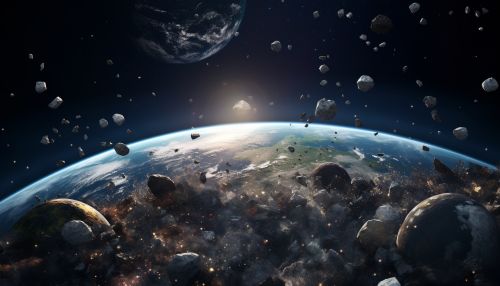Space debris
Introduction
Space debris, also known as space junk, space pollution, or space waste, refers to defunct objects in space, primarily in Earth's orbit, which no longer serve a useful function. These can include everything from spent rocket stages, defunct satellites, fragments from disintegration, erosion, and collisions, to abandoned launch vehicle stages, mission-related debris and fragmentation debris.


Origin and Composition
Space debris is a byproduct of the approximately 5,000 launches of communication, weather, navigation, and spy satellites since the start of the Space Age. It is composed of natural micrometeoroids as well as artificial particles, such as paint flakes, coolant droplets, and solid rocket exhaust particles. The majority of space debris is the result of satellite breakups and collisions.
Distribution and Density
The distribution of space debris around Earth is not uniform. The highest concentration of debris is found in the Low Earth Orbit (LEO) and the Geostationary Orbit (GEO). The density of the debris in these orbits poses a significant threat to both manned and unmanned space missions.
Risks and Dangers
Space debris poses a significant risk to space missions. Even small debris can cause significant damage due to the high velocities involved. Collisions with debris have the potential to create more debris, leading to the possibility of a catastrophic chain reaction known as the Kessler Syndrome.
Tracking and Monitoring
Tracking and monitoring of space debris is a critical aspect of space operations. Various organizations around the world, such as the U.S. Space Surveillance Network (SSN) and the European Space Agency (ESA), are involved in tracking and cataloging space debris.
Mitigation and Remediation
Mitigation measures aim to minimize the creation of new debris, while remediation measures aim to remove existing debris. Mitigation measures include design changes to prevent accidental explosions, minimizing the release of mission-related objects, and post-mission disposal of spacecraft. Remediation measures, on the other hand, are still largely theoretical and include ideas such as using lasers to deorbit debris or capturing and removing debris with nets or harpoons.
Legal and Policy Aspects
The legal and policy aspects of space debris are complex and involve international law, space law, and the policies of individual nations and international organizations. The Outer Space Treaty of 1967 is the primary international treaty governing space activities, but it does not specifically address space debris.
Future Implications
The future implications of space debris are significant. If current trends continue, the number of debris in space will continue to increase, posing an ever-greater risk to space missions. The development and implementation of effective mitigation and remediation measures are therefore of critical importance.
